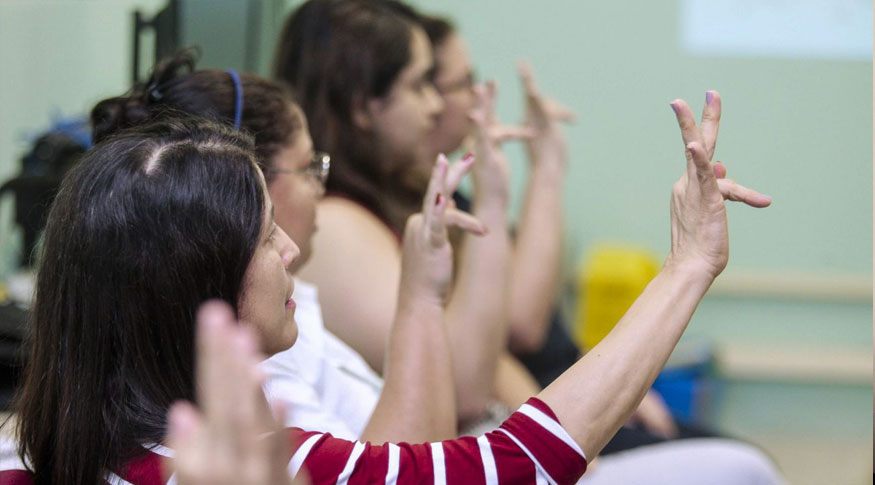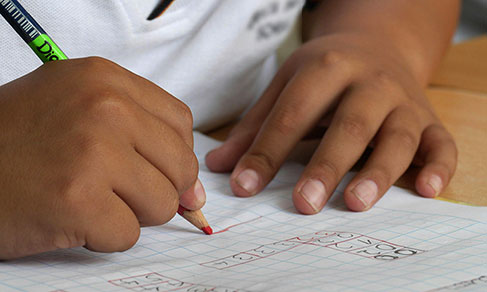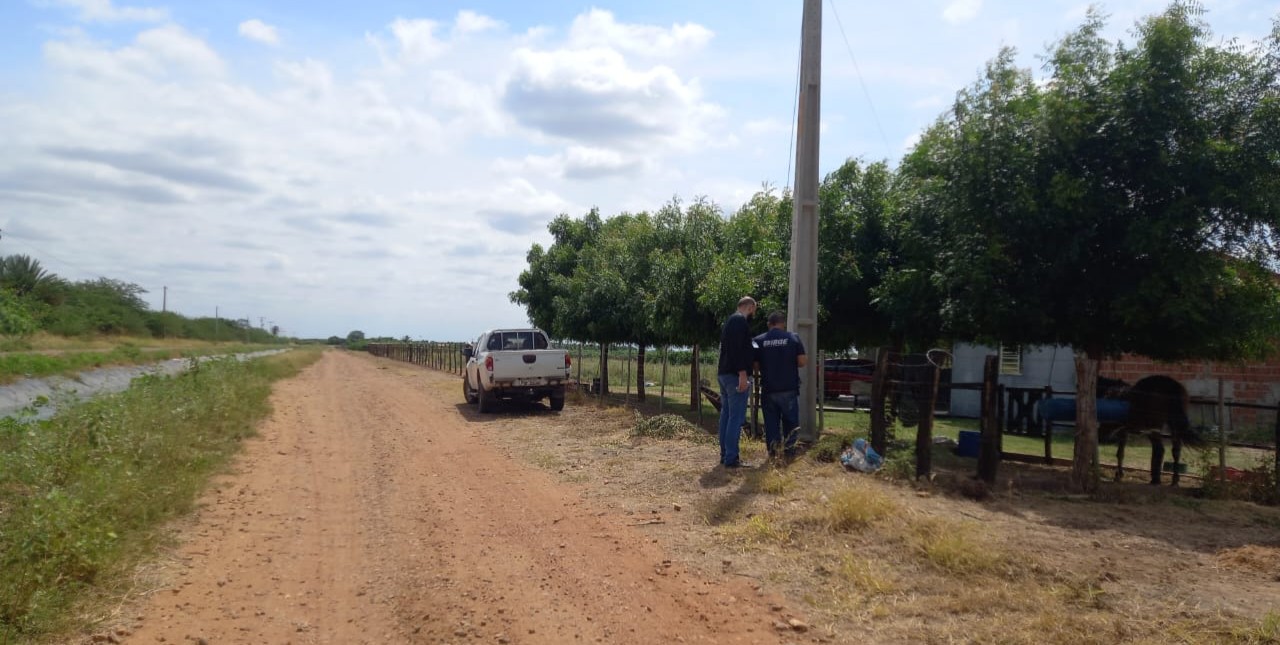PNS
One out of every four elderly persons had some time of disability according to data of 2019
August 26, 2021 10h00 AM | Last Updated: August 31, 2021 10h57 PM
Highlights
- In 2019, the number of persons aged two and over with disabilities in the country amounted to 17.3 million.
- Almost half (49.4%) of the population with disabilities was elderly.
- 25.4% of the population with disabilities at working age, that is, aged 14 and over were employed in 2019. Level of schooling is even lower in the population with mental deficiency: 4,7%.
- Among persons aged five and over that could not hear, 35.8% knew how to use the Brazilian Sign Language (Libras). This percentage reaches 3% among those with severe hearing impairment.
 The use of the Brazilian Sign Language was investigated by PNS for the first time - Photo: Ricardo Amanajás/Pará Local Branch
The use of the Brazilian Sign Language was investigated by PNS for the first time - Photo: Ricardo Amanajás/Pará Local BranchAlmost half (49.4%) of the 17.3 million persons with disabilities 17,3 in Brazil in 2019 were elderly, that is, aged 60 and over. Considering the total population by age groups, one out of four elderly perons (24.8%) had some type of disability. Visual impairment was the most common for that age bracket: 9.2% of the elderly reported having difficulty or not being able to see at all. Data come from the National Survey of Health (PNS) 2019 – Life cyclds, released today by the IBGE.
“Having as references the Convention on the Rights of Persons with Disabilities and the Brazilian Law of Inclusion, we see that disability is a changing concept formed by three main dimensions: impediments, barriers and restrictions to the participation of these persons in comparison with the rest of the populatin. And as the population grows older, impediments appear such as, for example, less visual, auditory and motor acuity. That accounts for the high percentage of elderly persons with disabilities,” says the survey analyst Maíra Lenzi.
The number of persons with hearing impairment also increases with the age: about 1.5 million persons suffering from that were over 60 years of age. That is equivalent to 4.3% of the elderly The use of some hearing resource such as a hearing device or a cochlear implant was observed among 0.8% of the population above two years of age, regardless of any disability or of the level of difficulty of persons. Among the elderly, the percentage was 3.1%
The survey also estimated at 3.3 million the number of elderly with some type of funcitonal limitation to perform Activities of Daily Living (ADL), like dressing, feeding oneself or bathing. That figure corresponds to 9.5% of the persons in this age group. The proportion increases with age, and reached 18.5% among those above 75 years of age.
Only 5% of the persons with disabilities had a higher education degree
Approximately 67.6% of the population with disabilities did not have any schooling or had incomplete primary education, in comparison with 30.9% of persons without any of the disabilities surveyed. Persons without disabilities also were more than three times the percentage that got a higher education degree in comparison with persons with disabilities.
“Some studies show the difficulties these peopl face in their access to education from the start of their academic life, due to either the lack of accessibility or assistive, or the lack of conditions in schools to deal with diversity in the classroom. It is important to have knowledge and conditions that allow these persons to be able to be in school, be included and have access to information. Educatiom is a right for persons with disabilities. That is why these data are important for the creations ou public policies aimed at persons with disabilities,” Ms. Lenzi explains. Only 5.0% of the persons with disabilities aged 18 and over had gotten a higher education degree. Among persons without disabilities, 17.0% had.
In the case of those with mental deficiency, inequalities are even bigger: this group had the smallest percentage of persons with at least a high school diploma (10.5%) and the biggest percentage without schooling or with incomplete high school (78.4%).
Inclusion in the labor market is also different among persons with disabilities. Only one out of every four persons in the population at working age (25.4%) was employed in 2019. Employment population ratio for the population in general was, at the time, 57.0% and, among persons without disabilities, 60.4%.
The survey showed that the employment population ratio of this group can be related to the smaller participation in the workforce. In 2019, only 28.3% of the persons with disabilities aged 14 and over were in the workforce, whereas that figure reached 60.0% among persons without disabilities. When asked about the reasons for not taking any action to find a job, 48.9% of the persons with disabilities reported health problems; 28.8% reported not wanting to work and 10.5% reported not being able to find a job for being very young or very old.
Also among persons with disabilities, there were differences in employment population ratio depending on the type of disability. Persons with visual impairment (32.6%) and hearing impairment (25.4%) are more present in the labor market than those with physical disability in the upper limbs (16.3%) or the lower limbs (15.3%). In the same indicator, persons with menatl deficiency were in more uneven conditions: only 4.7% of them were employed.
About 22.4% of the persons aged 5 to 40 with hearing impairment knew how to use Libras
For the first time, PNS investigated the use of the Brazilian Sign Language (Libras). The survey analyst says the inclusion of this topic provides more knowledge about the life of persons with hearing impairment. “This indicator allows us to understand how communication takes place between a person with hearing impairment and their family, once the question abou Libras was asked to all the population interviewed and not only to those with hearing impairment,” the researcher says.
“Besides, information is important so that we do not generalize persons with hearing impairment: by analyzing data, it is possible to see that not all of them can communicate using Libras, because they speak, communicate orally, and many time with the help of lip reading. Therefore, they need other accessibility resources, such as, for example, subtitles, besides needing distinct educational proposals,” she adds.
From the total number of persons aged five and over who could not hear at all, 35.8% knew how to use Libras. Among persons who had some difficulty hearing, the percentage was 3.0%.
The survey also investigated knowledge of libras among persons aged 5 to 40 years of age who reported having at least some difficulty hearing. They amounted to 1.7 million in 2019. This section was chosen for analysis because there are persons who lost hearing with age and continued to communicate in their mother tongue, that is, orally.
In this age group, of persons who reported severe difficulty hearing or not being able to read at all, 22.4% knew how to use Libras. Among persons aged between 5 and 40 who could not hear at all, 61.3% did not know how to use that language.




















